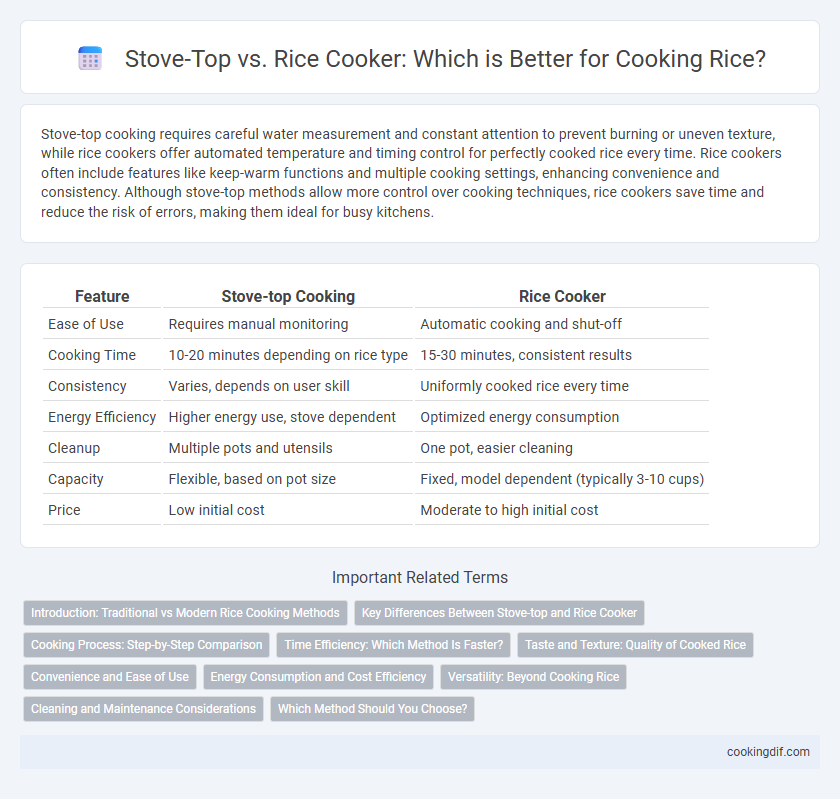Stove-top cooking requires careful water measurement and constant attention to prevent burning or uneven texture, while rice cookers offer automated temperature and timing control for perfectly cooked rice every time. Rice cookers often include features like keep-warm functions and multiple cooking settings, enhancing convenience and consistency. Although stove-top methods allow more control over cooking techniques, rice cookers save time and reduce the risk of errors, making them ideal for busy kitchens.
Table of Comparison
| Feature | Stove-top Cooking | Rice Cooker |
|---|---|---|
| Ease of Use | Requires manual monitoring | Automatic cooking and shut-off |
| Cooking Time | 10-20 minutes depending on rice type | 15-30 minutes, consistent results |
| Consistency | Varies, depends on user skill | Uniformly cooked rice every time |
| Energy Efficiency | Higher energy use, stove dependent | Optimized energy consumption |
| Cleanup | Multiple pots and utensils | One pot, easier cleaning |
| Capacity | Flexible, based on pot size | Fixed, model dependent (typically 3-10 cups) |
| Price | Low initial cost | Moderate to high initial cost |
Introduction: Traditional vs Modern Rice Cooking Methods
Stove-top rice cooking relies on direct heat control and manual timing, requiring attention to water ratios and simmering to achieve the perfect texture. Rice cookers offer automated temperature regulation and cooking cycles, using advanced sensors to optimize moisture and heat for consistent, effortless results. Modern rice cookers integrate fuzzy logic or induction heating technology, enhancing precision compared to traditional stove-top methods.
Key Differences Between Stove-top and Rice Cooker
Stove-top rice cooking requires manual monitoring of water levels and heat adjustments to prevent burning or undercooking, offering greater control but demanding more attention. Rice cookers use automated temperature sensors and timers to deliver consistent, evenly cooked rice with minimal effort, often including settings for different grain types. While stove-top methods are versatile for various cooking styles, rice cookers excel in convenience and precision, reducing the risk of overcooked or uneven rice.
Cooking Process: Step-by-Step Comparison
Cooking rice on a stove-top involves boiling water, adding rinsed rice, covering the pot, and simmering for 18-20 minutes with occasional stirring to prevent burning, followed by resting off heat for 10 minutes. A rice cooker automates the process by using precise temperature sensors and timers to cook rice evenly without oversight, switching to a warming mode once done. The rice cooker simplifies the cooking process and reduces the risk of undercooked or burnt rice compared to manual stove-top methods.
Time Efficiency: Which Method Is Faster?
Stove-top cooking typically requires 15-25 minutes depending on the rice variety, while rice cookers automate the process, often completing it in 20-30 minutes with minimal supervision. Rice cookers provide consistent results by precisely controlling temperature and cooking time, which can reduce overcooking or undercooking errors common in stove-top methods. For busy households, rice cookers offer time-saving convenience, allowing multitasking during the cooking cycle, whereas stove-top cooking demands more active monitoring.
Taste and Texture: Quality of Cooked Rice
Cooking rice on a stove-top allows precise control over heat adjustments, which can enhance the texture by producing rice with distinct, fluffy grains or a slight crispiness depending on technique. Rice cookers consistently deliver evenly cooked rice with optimal moisture retention, resulting in a soft and tender texture ideal for most varieties. Taste differences are subtle but rice cooked on a stove-top may develop a nuttier flavor due to occasional browning, whereas rice cookers prioritize uniformity and convenience.
Convenience and Ease of Use
Rice cookers offer unmatched convenience with automated settings that control cooking time and temperature, ensuring perfectly cooked rice without constant supervision. Stove-top methods require manual attention and frequent stirring to prevent burning, making the process more labor-intensive and prone to inconsistencies. For users seeking ease of use and hands-off cooking, rice cookers provide a reliable and efficient solution.
Energy Consumption and Cost Efficiency
Stove-top rice cooking typically consumes more energy due to longer cooking times and heat loss, while electric rice cookers use precise temperature control to minimize energy use. Rice cookers offer cost efficiency by reducing electricity bills and preventing overcooking, which can save money on wasted rice. Investment in a rice cooker is justified by lower long-term operational costs compared to continuous stove-top use.
Versatility: Beyond Cooking Rice
Stove-top methods offer the flexibility to cook various rice dishes by adjusting heat and timing, making it ideal for recipes that require sauteing or layering flavors. Rice cookers come with programmable settings that extend versatility to steaming vegetables, making porridge, and even baking cakes, providing multifunctional kitchen convenience. Choosing between the two depends on whether you prioritize hands-on control or automated versatility for diverse meal preparations.
Cleaning and Maintenance Considerations
Stove-top rice cooking often leads to burnt or stuck rice residues on the pot, requiring scrubbing and soaking for thorough cleaning, while rice cookers feature non-stick inner pots that simplify cleanup and reduce the risk of residue buildup. Rice cookers typically demand less maintenance, with detachable components like the inner pot and steam vent being dishwasher-safe or easy to rinse. Frequent use of stove-top methods may also cause discoloration or warping of cookware, unlike the durable design of most electric rice cookers that preserves their functionality over time.
Which Method Should You Choose?
Stove-top cooking offers precise temperature control and flexibility for different rice varieties, making it ideal for experienced cooks who prioritize texture customization. Rice cookers provide convenience with automated cooking programs and consistent results, especially beneficial for busy households seeking hassle-free preparation. Choosing between the two depends on your preference for hands-on control versus ease and reliability in daily rice cooking.
Stove-top vs Rice cooker for cooking rice Infographic

 cookingdif.com
cookingdif.com